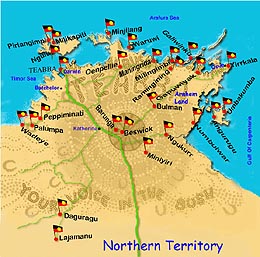|
|

Flags
indicating the extent of the BRACS network. Courtesy:
TEABBA
|
The
Broadcasting for Remote Aboriginal Communities Scheme (BRACS),
was introduced by the Federal government in 1987 in response
to the launch of the Australian satellite, Aussat. Aboriginal
and Islander people were concerned about the impact of the
satellite and requested resources that would allow them
to:
- broadcast
locally produced radio and video material
- receive
mainstream radio and television programs
- control
what was being broadcast into their communities.
The
concept was to give Aboriginal and Islander people, access
to and control of their own media at a community level.
Due to limited funding, basic domestic audio and video equipment
was used. Each installation comprised a cabinet to house
a cassette recorder, radio tuner, microphone, speakers,
switch panel, two VHS VCRs, television set, video camera,
two UHF television transmitters, FM transmitter, satellite
dish and two decoders. When the program finished towards
the end of 1991, Telstra had installed 80 BRACS units across
Australia.
The
Top End Aboriginal Bush Broadcasting Association (TEABBA)
was set up in 1989 specifically to work with and provide
support for the 29 Top End BRACS communities. The
TEABBA satellite radio
network is unique in the way it is managed and operated
by Aboriginal and Torres Strait Islander broadcasters from
the Top End of the Northern Territory. The network
was set up to promote broadcasting from studios at the community
level. The network broadcasts in many languages and music
styles, reflecting the diversity of its audience and coverage
area.
TEABBA
is:
…
committed to fostering the broadcast image from the bush,
to give the broadcasters a voice and a unique communications
network spanning the Top End, that is where our strength
lies and we see our role growing in this area. (Wyatt,
1996)
The
material in this case study has been adapted from a paper
written by Evan Wyatt, Broadcast Engineer from Top End Aboriginal
Bush Broadcasting Association (TEABBA).
 |
Case
studies developed by the Professional Support and
Curriculum Directorate and supported by the Multicultural
Programs Unit of the NSW Department of Education and
Training in partnership with the Powerhouse Museum
|
 |
|